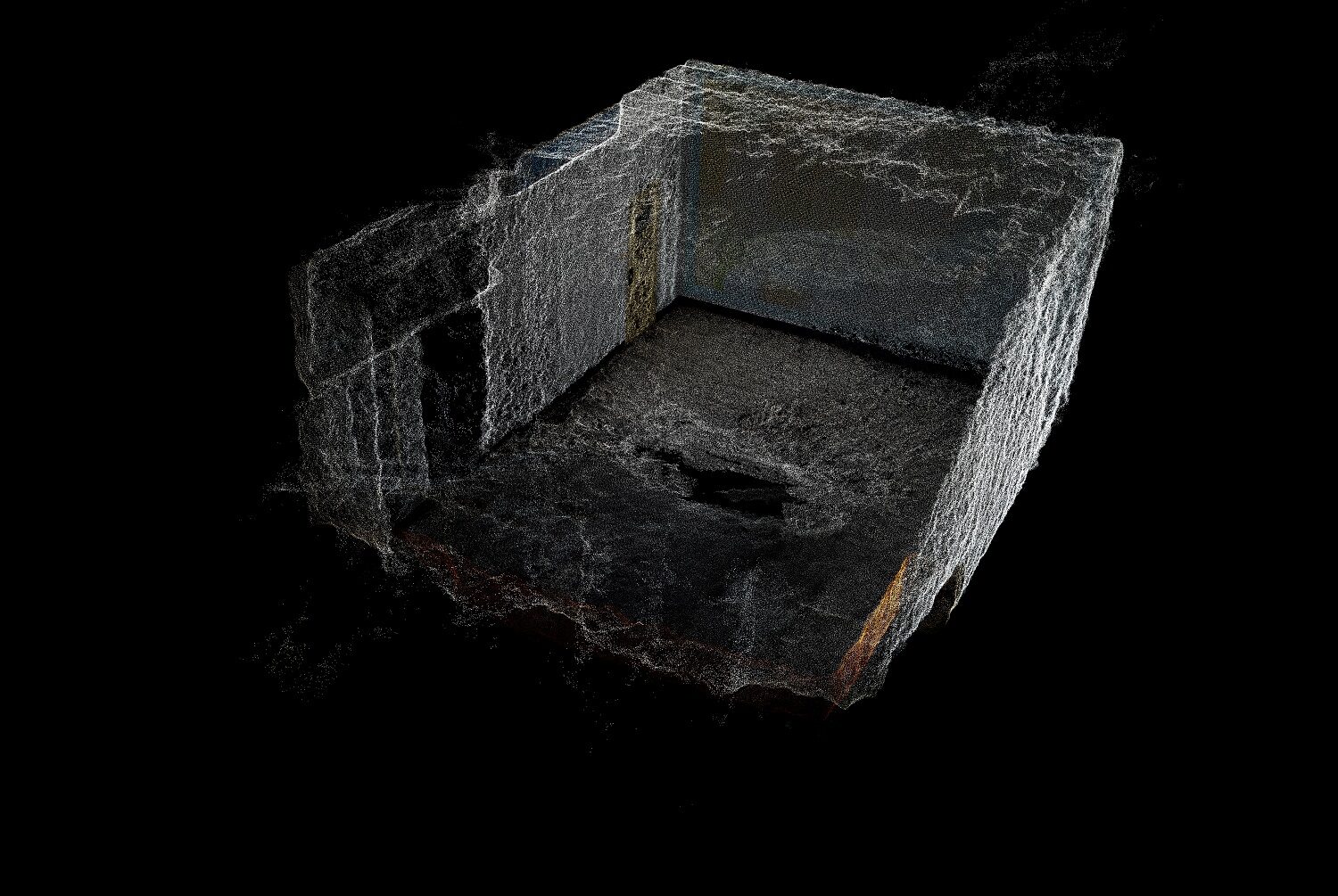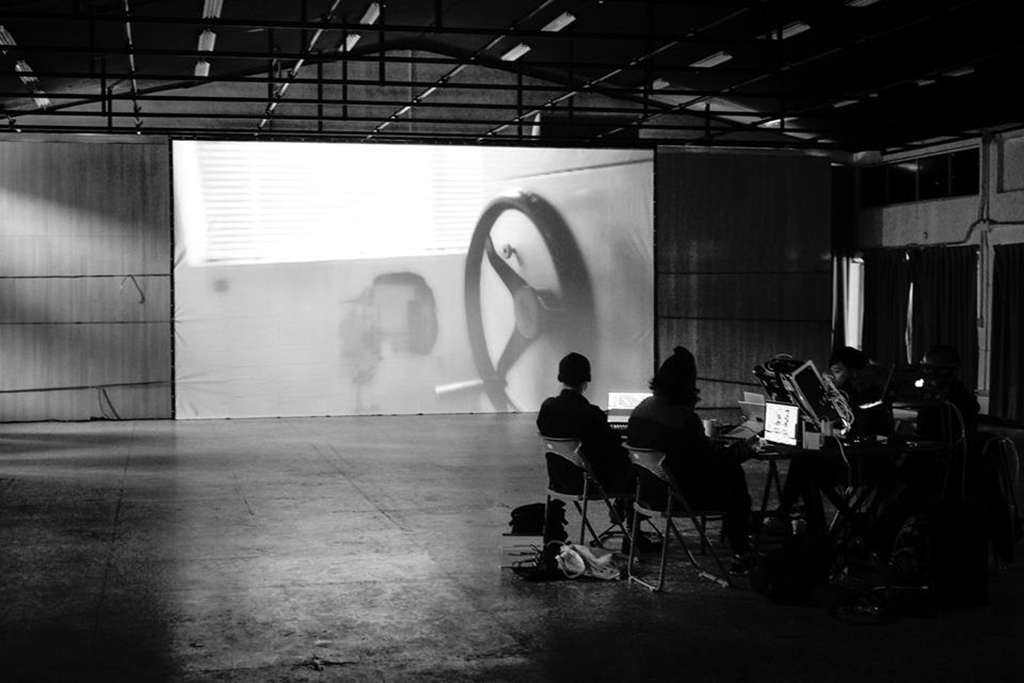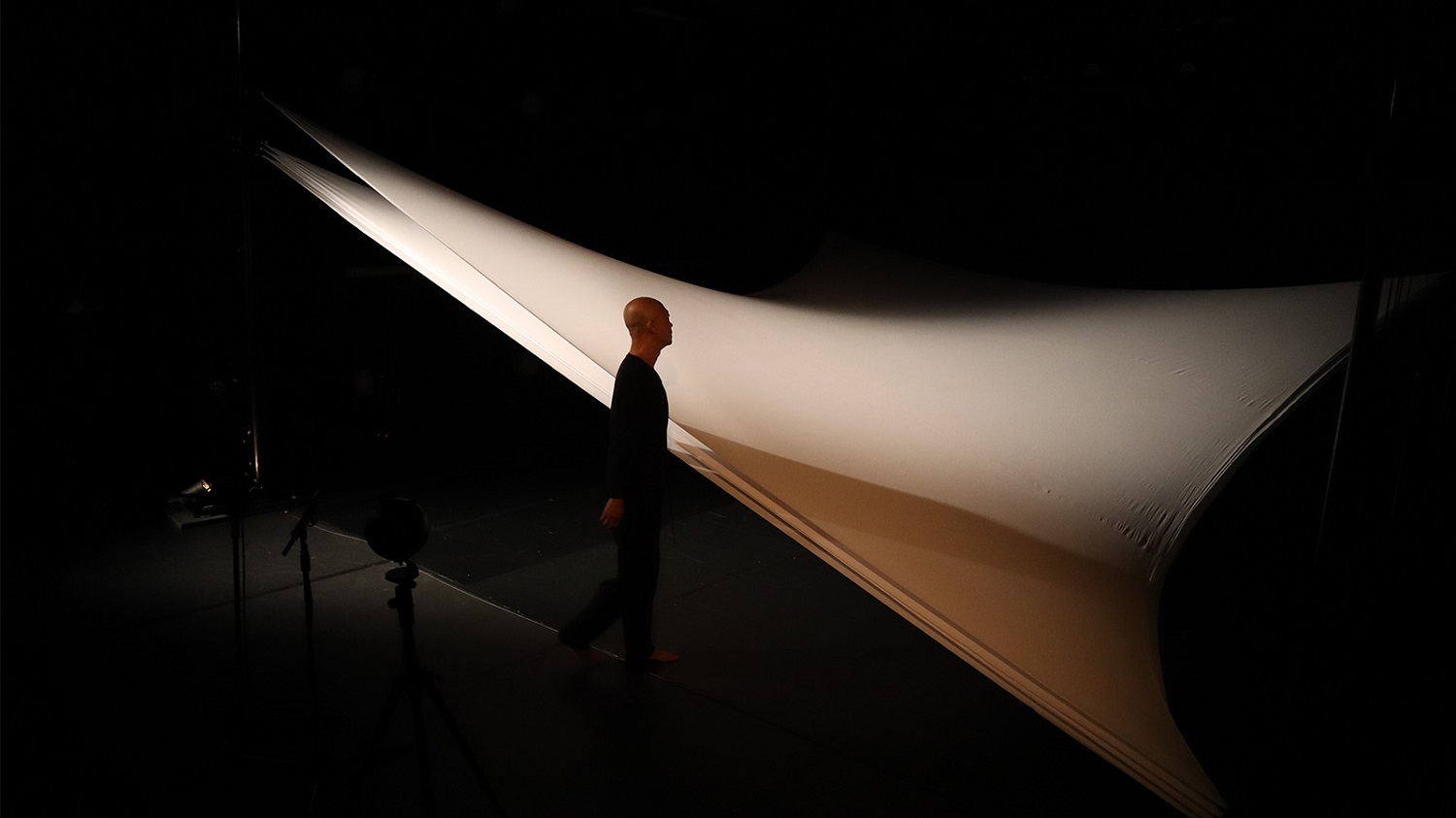MASHUP。搗亂。作為一組動詞,「MASHUP」的畫面感生動,仿若擲地有聲,自帶雙重驚嘆號,「搗亂」是無傷大雅的惡作劇,看著看著有砸成一鍋其樂融融之意。如果要在前身是空軍總部的空總臺灣當代文化實驗場鬧一場,即將開展的「MASHUP all the CREATORS」想徹底翻覆的究竟是什麼?
「MASHUP all the CREATORS」(搗亂了所有的創造者)展覽源自 2018 年第一屆「CREATORS創作/研發進駐計畫」,徵件分成「實驗室主題提案」與「自主提案」,個人或團體皆可報名,挑選具備跨領域、實驗性與創造力的文化實踐計畫。從發想到行動,C-LAB 提供空間與經費,獲補助的創作者們進駐空總三到六個月進行孵化,團隊皆配備一名陪伴觀察員,參與討論、撰寫後續報導,關注生產實踐的整個過程。
第一次徵件共13組創作者入選,內容涵蓋音樂、實驗聲響、錄像、舞蹈、馬戲、空氣結構與文化研究,讓創作者們將 C-LAB 作為扎根的地基,與C-LAB 內部歷史場域和外部公眾產生關係。本次展出十組,包含「謝杰廷/譯譜者:在譜間轉譯的研究創作計畫」進行對不同譜的研究與轉譯;吳孟軒以身體提問「身為藝術工作者,我們如何組織自己?」;「黃偉軒/沉浸式逝去影像考古計畫」與「劉時棟/”Lands”殘片文化實驗計畫」以個人創作做非典型的田野調查,探究私歷史和通用歷史與空間的互文;「在地實驗/Archive or Alive:劉守曜獨舞數位典藏研發計畫」施作數位掃描技術,實踐典藏表演的方法;「空氣結構 Lab」以建築背景突破空氣的既有結構;「圓劇團/”悲傷ㄟ曼波”――臺灣弄鐃文化的馬戲與錄像創作」與「野孩子肢體劇場/表演的政治性――惹內的陽臺在臺灣」以社會議題與臺灣民俗為基底,結合錄像與裝置敲擊表演本體;數位音像與動態影像計畫「ASC」(The Art Shelter and Cinema)和「燧人氏」在實驗場凝聚專業社群,舉辦聲光活動面向大眾。「MASHUP all the CREATORS」即是這十組團隊的究極成果發表。
 黃偉軒的「沉浸式逝去影像考古計畫」以個人創作做非典型的田野調查,探究私歷史和通用歷史與空間的互文。圖/黃偉軒提供
黃偉軒的「沉浸式逝去影像考古計畫」以個人創作做非典型的田野調查,探究私歷史和通用歷史與空間的互文。圖/黃偉軒提供
 數位音像與動態影像計畫「ASC」(The Art Shelter and Cinema)凝聚專業社群,舉辦聲光活動面向大眾。圖/噪流提供
數位音像與動態影像計畫「ASC」(The Art Shelter and Cinema)凝聚專業社群,舉辦聲光活動面向大眾。圖/噪流提供
原為軍方禮堂的中正堂,是 C-LAB 場址中保留最多空軍總部時期規畫的空間。挑高八公尺,精神標語林立,在威武不屈的中正堂裡,嘗試嵌入不同的議題與形式,好像打彈珠台,「碰!」的一拉,讓創作者和中正堂既有的銅牆鐵壁相互碰撞。
「實驗」是C-LAB的一貫精神與態度;「MASHUP」則為實驗場對文化生態系的想像新向度。這次的展覽雜揉動態表演與靜態裝置,重組各個實驗計畫,解構中正堂。中正堂裡,空間的變造首先發生,在主舞台與觀眾席之間將搭建一座可以走動的平台橋,並連接一處象徵意義上的後台,破壞原有的視角規範,隨著前台與後台的分野消失,原本無隔間的大型空間將隨著不同的演出變動,表演不用只在舞台,收看的眼睛無需釘在座位上,演出與觀看自由發揮,試圖模糊表演者與觀眾的分別,秩序標準通通逸散。
 「空氣結構 Lab」以建築背景突破空氣的既有結構。圖/空氣結構 Lab提供
「空氣結構 Lab」以建築背景突破空氣的既有結構。圖/空氣結構 Lab提供
「MASHUP all the CREATORS」展覽內容區分為迴圈、挖掘、聲相、回放、構成五類,「迴圈」是對空軍基地的重新想像;「挖掘」藉由物件的搜集和掃描,重新排列對此地的觀看方式;「聲相」是音像實驗的聲光體驗再複習;「構成」打散、重組進駐時的實體創作成果,二度詮釋;「回放」的發生在搭建的嫁接橋下,九個數位螢幕一起播放計畫期間於 C-LAB 舉辦的活動座談紀錄影片。展覽把動態的表演與靜態的裝置一起放進果汁機,當觀眾在現場看某一演出的同時,旁邊的事件回放也可能正在發生,看演出的眼睛與看展的眼睛同時聚焦。中正堂於是成為一個集合 C-LAB 文化生態系的可能舞台,雞生蛋生雞,翻覆反而幫建造鋪墊了前提。
把不可能的關係重新連接,使其產生意料之外的關聯,這正是在 C-LAB 持續發生的實驗。去年「再基地:當實驗成為態度」思考的是空軍總部的重新出發,以實驗為核,重新想像場域的曾經與未來光景。而「MASHUP all the CREATORS」吞吐動態表演與靜態裝置,轉動展演的萬花筒,搗亂舊秩序,在中正堂現地解構與重組。一生滅一世界,毀滅即是創造的永劫回歸。
 「在地實驗/Archive or Alive:劉守曜獨舞數位典藏研發計畫」施作數位掃描技術,實踐典藏表演的方法畫。圖/在地實驗提供
「在地實驗/Archive or Alive:劉守曜獨舞數位典藏研發計畫」施作數位掃描技術,實踐典藏表演的方法畫。圖/在地實驗提供
每件作品的產出與再造,都是 C-LAB 的一元復始。6 月 14 號伊始,為期一個月的「MASHUP all the CREATORS」(搗亂了所有的創造者)使用 C-LAB 裡肅穆方正的中正堂為展覽空間。作為前空軍總部禮堂,文化展演進駐後,中正堂改變用途,兩年裡舉行了各式大型論壇與活動。不同的歷史時期產生不一樣的空間體驗,讓實驗場基地的想像氣旋得以流動,促使觀眾對中正堂及 C-LAB 場址裡各種歷史建物與空間生長出新感知。展覽開幕當天,由燧人氏的張方禹與方宜正的音像表演揭幕,想知道異質的中正堂如何萬象更新,歡迎一起來大禮堂不升旗不聽訓,這邊看看那邊躺躺,一起搗亂一起鬥熱鬧。
2018 年第一屆的「CREATORS 創作/研發進駐計畫」藝術家與團隊質地錯落殊異,表演與作品或靜或動,形式豐滿。譬如乍聽概念特別抽象的研究計畫「譯譜者:在譜間轉譯的研究創作計畫」。「譜」不單單是傳統定義裡可以被演奏的樂譜,生活中不同的譜皆可以被視為記事的某種方法。「譯譜者」謝杰廷找來音樂家鍾玉鳳、黃思農以及舞蹈家鄭傑文,在譜與譜的轉譯和衝突之間造新譜,以音樂和肢體重新演繹。開演前,「譯譜者」將在中正堂主舞台與觀眾席之間的空地,畫9×9公尺的大「譜」,來者可以任意席地而坐,選擇喜歡的視角觀看。
 謝杰廷「譯譜者:在譜間轉譯的研究創作計畫」進行對不同譜的研究與轉譯。圖/謝杰廷提供
謝杰廷「譯譜者:在譜間轉譯的研究創作計畫」進行對不同譜的研究與轉譯。圖/謝杰廷提供
圓劇團的計畫 「悲傷ㄟ曼波」,取材自臺灣喪葬禮俗裡的弄鐃科儀,劇團表演結合馬戲雜技、錄像與馬戲影像,駐村期間,圓劇團找來許家班師傅於實驗場裡弄鐃,當群眾圍觀,舞台即無中生有、憑空而現。這次在中正堂的展演,圓劇團邀請藝術家陳長志,把對傳統儀式的研究與表演形式變造成動態影像裝置。弄鐃科儀使用的道具及象徵物,如火圈、木製長椅凳等或可成為盛裝表演影像的容器,播放小型投影。「悲傷ㄟ曼波」則尾隨其後,於 7 月正式在兩廳院戶外廣場開鑼。

 吳孟軒「身為藝術工作者,我們如何組織自己?」。圖/吳孟軒提供
吳孟軒「身為藝術工作者,我們如何組織自己?」。圖/吳孟軒提供
吳孟軒的提問:「身為藝術工作者,我們如何組織自己?」同時有靜態的裝置與動態的演出。研究成果原來可以是行為,同時也是裝置。展出期間,吳孟軒放置一座 6×2 公尺長桌,邀請合作者們隨機前來,回歸展場中進行互動,重新和研究計畫與中正堂發生關係,人與桌遂成一半動半靜的現場雕塑。吳孟軒同時帶來另一講座式表演,進行中長桌將分解成十二張小桌,即時邀請觀眾參與,重新體驗她在進駐期間對議題的各種思考。且看「身為藝術工作者,我們如何組織自己?」如何裝置,如何行為。